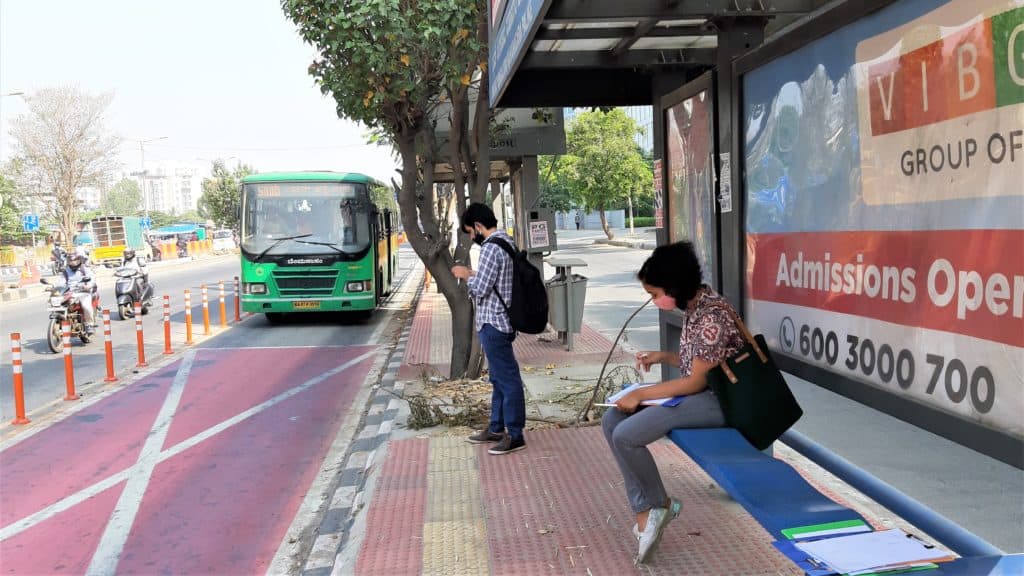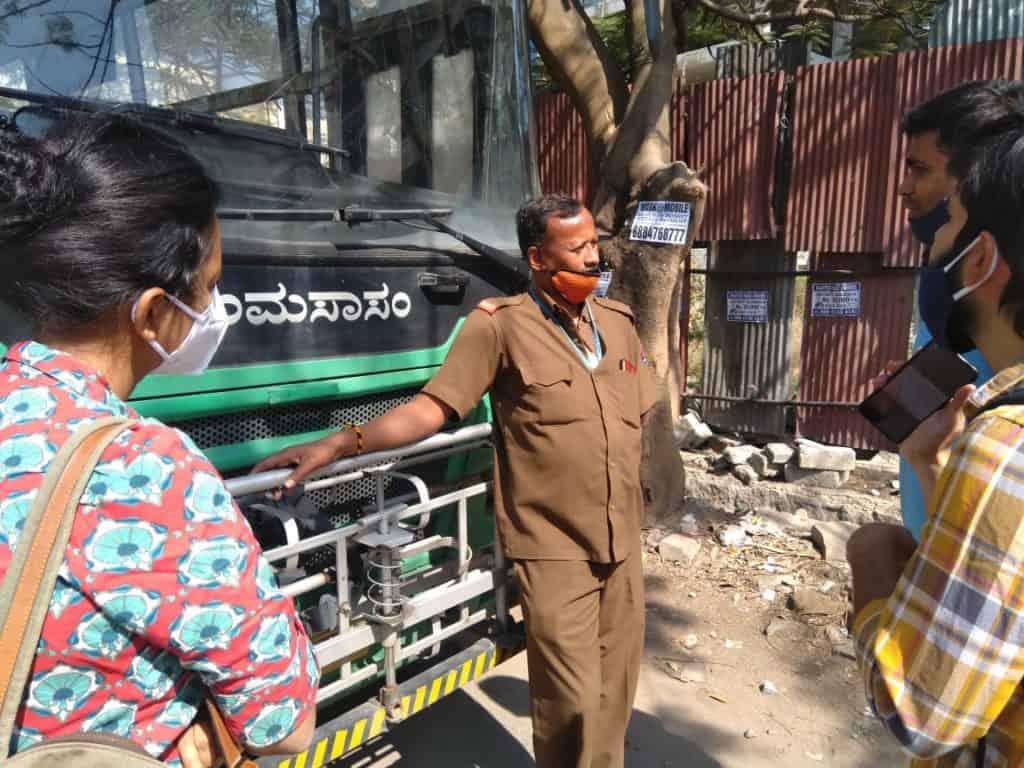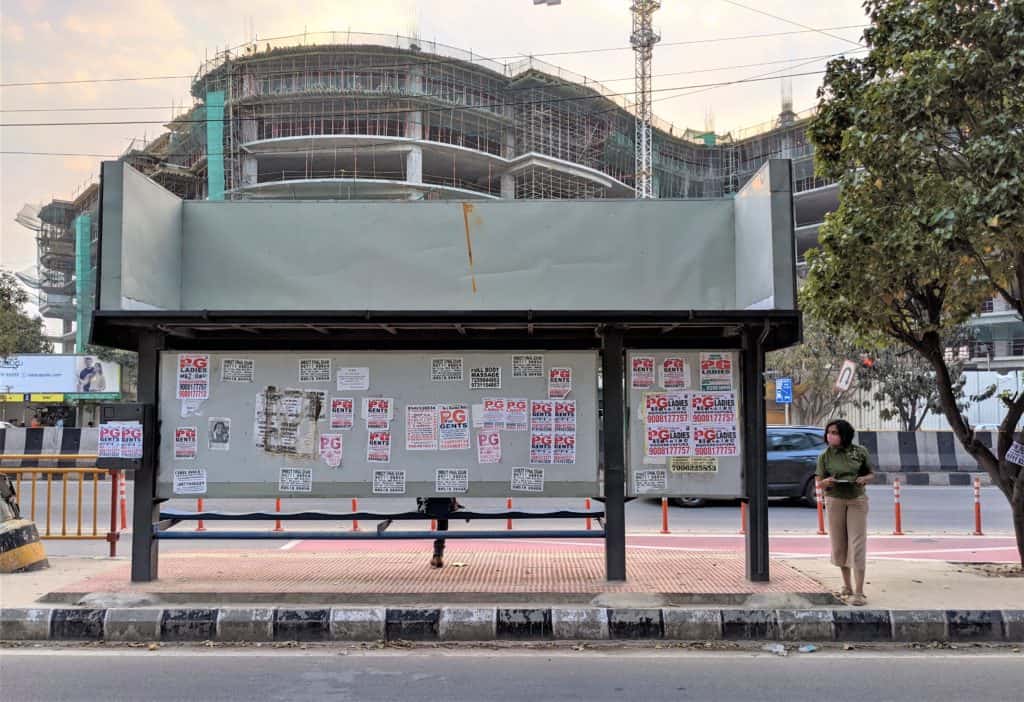With Bengaluru becoming the most traffic-congested city in the world in 2020, mass transit is the key ingredient for a sustainable, low carbon footprint future and the only solution to decongest Bengaluru’s roads. However, the perception that cost effective transport options are primarily for use by the economically weaker section of the society, is a big worry.
The extensive bus network of Bengaluru, with a fleet size of over 6775 buses, is the largest in India, and among the 20 largest in the world. Why then is it not leveraged as a solution to its traffic congestion?
Even with the alarming increase in traffic, why is the city steadily adding more private vehicles while the use of public transport is hitting a new low at just 48%? Why is Bengaluru not choosing the bus?

Convenience, reliability, overcrowding
To investigate this problem, we volunteered with Young Leaders of Active Citizenship (YLAC) and Sensing Local, which has been actively working with the Directorate of Urban Land Transport (DULT) to improve bus accessibility across the city as part of the #BengaluruMoving campaign.
Piloting this objective in Doddanekundi, we conducted a survey to ascertain the needs of regular and potential bus users alike. Our findings suggest that people perceive the entire experience of travelling by bus to be cumbersome and far more time-consuming than personal vehicles.
Convenience and Accessibility: More than 70% of our respondents walked to bus stops and reported poor infrastructure such as broken footpaths and the absence of streetlights.
No bus stop was equipped with parking facilities for cyclists, critical in strengthening the first mile and last mile connectivity. Besides the longer travel time in buses, the absence of these measures has further prolonged the journey and deterred potential users.
Reliability: Col. Deepankar Choudhary (Retd), a resident of Doddanekundi elaborated on the unreliability of the bus system that has affected his choice.
“If I were to take the bus to work, chances are I would be fired in a few days. If I were to take the bus to the airport, I would definitely miss my flight.”
Col. Deepankar Choudhary (Retd)
Over 30% of our respondents who rarely take the bus, echoed these feelings.
Contributing to the IT sector of Bengaluru, Doddanekundi itself is centred around the Bagmane Tech Park which attracts a large number of young professionals, all of whom stressed that ‘Time is Money’.
The absence of real-time tracking and non-adherence to the schedule has made it impossible to gauge the travel time and plan ahead.
Overcrowding: Undeniably, the risk of travelling in a closed and crowded public transport vehicle during the pandemic has posed a serious concern.
All our respondents, irrespective of the frequency of bus usage, almost unanimously agreed that overcrowding caused due to the absence of strict COVID regulations and lack of social distancing norms in buses has forced them to switch to private transport recently.

What needs fixing
Infrastructural Intervention: In November 2019, the government launched a welcome move to introduce the Bus Priority Lane from Silk Board to KR Puram. We interviewed several bus drivers who themselves noticed that travel time had considerably reduced since the inception, bearing testimony to its positive results. Moreover, the signal-free lane allowed buses to stick to their schedule and beat the traffic during peak hours.
Read more: Bus lane has reduced stress, travel-time for drivers, increased ridership for BMTC
This is significant in making buses more reliable. If scaled across the city, coupled with the installation of real-time arrival clocks at the bus stops, this can inculcate trust amongst users.

User Experience: While the pandemic poses a unique challenge to nudge citizens towards public transport, it also presents an opportunity to make much needed improvements to Bengaluru’s bus experience.
- In June 2016, Axis Bank in association with Bengaluru Metropolitan Transport Corporation (BMTC) launched ‘Axis Bank BMTC Smart card’, a Common Mobility Card that would offer commuters a cashless, hassle free bus experience. Unfortunately and ironically, for India’s tech capital, this plan still remains on paper. While contactless deliveries, identification and payments are on the rise the world over, there hasn’t been a better time than now for Bengaluru to adopt contactless digital payments in buses.
Read more: Govt support is only way BMTC can survive COVID: Experts
- In a country like India, where buses carry far more commuters than the number of seats available, a policy intervention to enforce strictly, a cap on the occupancy rates is imperative to address overcrowding. Further, these numbers could be made available to the public through real-time passenger information systems installed at public transit stations.
Information System: As migrants comprise half the city, it is important to address the cultural diversity of Bengaluru. Information about bus routes and bus numbers should be easily accessible and available by exploring diverse forms of media.
As we conducted bus infrastructure audits, the missed opportunities in ensuring a smooth bus user experience became strikingly clear.
For example, while there is a provision of voice announcements in some buses, these were hardly ever used. Almost all BMTC buses had digital screens that conveyed no information. There is a huge potential to ensure these screens display arriving stops in order to reduce dependency on Google Maps and in many cases, the conductors.
With the Metro yet to penetrate across the city, buses today are our only real mass transit option and the best chance we have at reducing traffic congestion.

With the use of public transport plummeting, it is critical to provide a safe and secure travel experience and in doing so, reform the public transport sector by providing valuable incentives for potential users to become regular and most importantly proud bus users.
An improved infrastructure system and strict policy interventions are essential in inculcating a behavioural shift to encourage more people to switch to the bus, during and after the pandemic.
Be a part of the change
If you live or travel to Doddanekundi and would like to volunteer to help improve your neighbourhood, please sign up here. You could also share your bus story by taking the survey.
[The authors are Mobility Champions for the #BengaluruMoving campaign with Young Leaders for Active Citizenship (YLAC). The #BengaluruMoving campaign aims to increase citizen engagement toward creating sustainable mobility solutions in Bengaluru. The views expressed in this article are the authors’ own.]
All inconsequential, as long as BMTC monopoly remains. If that’s to go, then a workable model can be as @ http://praja.in/en/blog/murali772/2019/07/16/outline-most-equitable-public-bus-transport-model
No idea of real time transit update of buses in bus stand. But real time availability of PG information seems very effictive from that picture.
When three people travel together, auto fare is cheaper than bus fare. Very irregular frequency. Every route should have moderate frequency depending upon the demand.REGULAR PUBLIC INTERACTION WITH OFFICIALS IN ALL MAIN ROUTES
Traveling time may delay but one thing I want to ask why the bus drivers never stops the bus exactly at bus stop . And if we see in Bangalore all the bus stop are provided before / after turning the road and also before and after the traffic signal and why there is traffic law’s for these drivers who won’t follow the trafic rule
Very important initiative and relevant pain points captured, I’m sure if we all contribute towards this thought process we’ll have much better outcomes in the future
First the BMTC should conduct survey and find it employees traveling from particular area to particular destination and run buses without much intermediate stops to ensure least travelling time. When the commuters are ensured with end to end connectivity they will select bus. Crowd should be avoided and untiring travel will attract people towards bus. They should be ensured of their reaching time to avoid delay in reaching their work places. This will definitely reduce congestion inturn reduce traveling time which again attract the people to bus. And many times private vehicle is cheaper than bus when more than one person is traveling. If these points are considered people can be attracted to bus
For BMTC to succeed synchronize bus pickup and drop to bus stands and metro stations with a UBer kind of APP. People will know when to pick the bus and when to catch metro real time
Make sure the conductor is talking to passengers properly with good behaviour. And I have live example if we do not have change the conductor will make us to get down from the bus. We need to carry the exact change. As my colleague she is travelling from Koramnagala to New Horizon college as she don’t have exact change the conductor made her to get down from the bus. It’s good that I was travelling to office on the same route I picked her went to office. This attitude should get change. If they need exact change in busses also there should be phone pe scanner should be get fixed so no problem of change.
First of all please be safe and wear mask properly also proper masks. Also, to note that rash driving and rude behaviour is also not very inviting. Lack of Pedestrian infra, social system and pollution aggrieved.
BMTC also needs to introduce more A/C buses in all the routs. Bangalore is not cold as it used to be once. It’s too sweaty to travel in BMTC overcrowded buses.
I believe there is a vital need to understand the size of the buses used by BMTC and other vehicles in comparison to the roads. Agreed, it BMTC buses are at home in places like outer ring road, that is seldom the case in inner parts of our city. For Example, New BEL road, inner Malleshwaram, Indiranagar, Ulsoor Road, inner Koramangala etc. A big vehicle covers the whole road and provides no way for other vehicles to pass it, even if it has halted.
It’s not practical to take a bus, that runs only on main roads, jampacked in rush hours, and no safety of self and valuables. I have lost my mobile, wallet and the same happened to my friends too. Carpool, bikes, cycles are still better options to commute. The icing on the cake is Bengalure’s road infrastructures it is just world-class.
You all are trying to fix the side effects or problems caused by bigger issue.
It’s high time governments start looking at other cities in the state and distribute the load, instead of developing only ONE single city.
Why do you think only cities like Bengaluru, Mumbai and Delhi facing the worst of pandemic. Because of high density of people. Jobs are created only these cities instead of distributing it.
Every government official, bureaucrats wants to earn their share of money.
This is the right time to think about other cities. That way futures disasters can be avoided or at least reduced in effect.
I see in all survey, there is one area which is not covered and considered. The area containing Panathur, Bhoganhalli, Doddakannali connecting to Sarjapur Road as well Carmelaram needs some bused. The bus stops at Outer ring road are somewhere 1.5 to 4 km and no-one expects to travel that far without proper buses.
Also why Bangalore doesn’t have Shared-auto system alike Noida, Gurugram cities on such small routes. It can definitely reduce burden on roads.
One Smart card to hop into any transport mode would be best. Bus, Metro, Shared Auto, Shared Taxi, Bike taxi, shared bike and cycles. Common booking App whereever booking required. Priority lanes for any shared mode of transports.